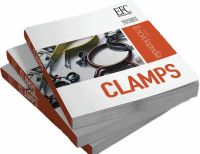The most popular types of clamps for hose/tube, wire routing and affixing.
Regardless of your application – hose/tube, wire routing or affixing – there are numerous types of clamps to fit your application solution. Many of these types of clamps appear in EFC’s on-line engineering guide (EFC Product Catalog of Engineered Components), specifically in our clamp “book” found here. The most popular clamp types include constant tension, crimp style, cushion/routing, worm-gear, T-bolt and V-band.
Constant Tension clamps come in various styles (CTB band, screw-drive w/ spring element or belleville washers, or with traditional springs). Constant Tension clamps enable spring-action to ensure a “constant tension” to prevent hose leaks due to pressure changes or thermocycling.
Crimp Style clamps include ear clamps that require an “ear” to be pinched to install. Advantages include ease of installation, tamper proof design, concentrated seal compression and are ideal for hard-to-seal applications like molded plastics and automotive applications.
Cushion and Routing clamps include metal “P clamps”, with or without a cushion, for affixing hose, tubes, pipes, cables or wire bundles. The clamps are affixed typically by using a bolt. Other types of routing clamps include both metal and plastic clamps of varying styles and designs for affixing or routing cables and wire bundles.
Worm-gear clamps are extremely popular as they can be removed or adjusted after installation and typically just require a screw-driver to install them. They come in varying styles for numerous application solutions. Worm-gear clamps can accommodate a range of diameters, which is a major benefit.
T-Bolt clamps are often used for heavy duty / high strength applications.
V-band clamps provide a secure connection and positive sealing for “coupling” together flanged joints. Available for high torque and with quick latch options. These clamps are often used in heavy-duty diesel engine exhaust and turbochargers.
For more information, or to explore any of these types of clamps (and others), please visit the clamp section of our website here.
